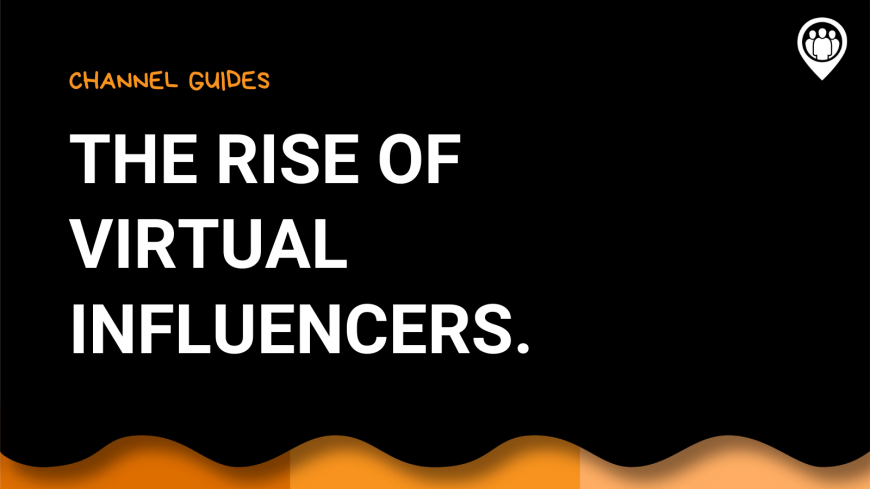The rise of the (virtual) Influencers
Sahail Ashraf posted on 18 April 2022
Okay, it’s not difficult to tell the difference between a real and virtual Influencer. But how popular are they? And do people buy through them?

Influencers are now a great big part of our lives. They have huge followings, and many of them make very lucrative careers out of marketing products and services. One thing that you may not know is that some of these Influencers are not even real. They’re virtual. And they have large follower numbers too. But what is it all about? And is the whole thing growing?
There are a multitude of ways in which virtual influencers can help promote products, and it’s becoming increasingly difficult to tell the difference between them and actual people as online content becomes more and more airbrushed, polished and manicured. Despite their sometimes negative connotations, digital products are growing in popularity through interest in NFTs and other trends, so whether you love them or not, they are here to stay.
In a recent study by The Influencer Marketing Factory, 1000 Americans were asked for their thoughts on the matter. We’ve put together the headline points below.
First up, the unimaginable
Virtual Influencers are more popular than you think. The study found that 58% of the people surveyed followed at least one virtual Influencer. That’s right, over half followed someone who isn’t actually real.
This is an interesting aspect. It shows just how many virtual Influencers have been accepted. And it throws up an intriguing question. To what extent do these virtual Influencers influence buying decisions? If over half of people follow them, surely that means they are having a huge impact on sales?
Not quite. Full acceptance is not there quite yet. Basically, the survey asked people if they had ever bought a product recommended by a virtual Influencer. And 65% of people said they hadn’t.
And when the researchers asked why they had not bought, 51% simply said they were ‘not interested’.
That is actually quite a good thing for the virtual Influencer industry. Wanting to buy from a real person, for example, was not a strong reason for not buying. Just not being interested means that the sales process here very much resembles ‘normal’ sales. Buyers can simply be uninterested in the product.
The most virtual Influencers are followed on YouTube (28.7%), with Instagram being the second most popular location (28.4%). It’s telling that the third most popular platform is TikTok. Visual work always gets the most engagement, and this is the same for virtual Influencers.
It’s also important to note here that people are following virtual Influencers on these platforms, the platforms where Influencer marketing took off and grew so quickly. To users, these virtual people are just seen as Influencers on channels where Influencers do their thing.
The report covers a lot. Another key interesting finding is that a large number of respondents thought virtual Influencers were more relatable.
Why use virtual Influencers?
It’s easy to see why a number of brands are keen to engage with this new breed of influencer, especially since creating personas for brands to promote shows a new movement emerging within influencer marketing.
There’s a view that brands can work with virtual influencers safely since the pitfalls that will naturally arise working with their real equivalents are lower. It’s safer to work with a CGI persona because it’s less likely to result in unpredictable behavior. And real-life Influencers can be problematic. An offensive tweet can come out of nowhere, for example. Or there could be some hidden content from the past that compromises a brand’s values.
On the other hand, Influencer marketing works because of the bond a good Influencer has developed with their audience. That bond is built on authenticity and trust. It is a real person who has a certain personality and experience that resonates with an audience. As long as audiences don’t mind the fact that they are literally following a fabricated lifestyle, things are okay.
Why brands might use virtual Influencers
If you’re considering using a virtual Influencer in the future but are on the fence about it, here are five reasons why you might take the plunge.
- Streamline product integration. Each part of a virtual influencer’s story can be infused with the life cycle of a product – and in a compelling way. With real-life influencers, this can be more challenging.
- Communication can be automated. Digital influencers can conduct hundreds of simultaneous conversations. Where is that possible in real life?
- Imagine, create, and invent. Virtual worlds offer unending creative opportunities. Work with a robot is less restricted compared with working with a human.
- Risk management. Content is controlled by brands. Virtuals don’t have embarrassing nights out or say the wrong things on their youTube videos.
- Definitely here to stay. In the world of influencer marketing, virtual influencers are not going anywhere. With its ability to speak many languages, and its ability to be programmed to cater to different regions, we only see growth in their future.
Like our last point said, they are here to stay. And they might just be the next vital piece of a brand’s marketing toolkit.
Are you a digital marketer? Great, because we’d like to introduce you to your new best friend. Locowise helps you handle all your data and use all the metrics that matter to create incredible campaigns, all in one place. Get in touch to find out more.




